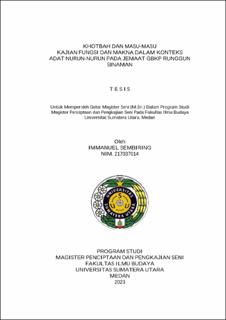| dc.description.abstract | This thesis is entitled Sermon and Masu-masu: A Study of Function and Meaning in the Context of Nurun-nurun Custom at GBKP Runggun Sinaman Congregation. The purpose of this study is to describe the function of sermons and masu-masu and the meaning in the text of sermons and masu-masu where both have the same purpose in different presentation contexts. to examine the function and meaning of sermons and masu-masu the author uses methods: field research acting as a participant observer, by conducting interviews, recording data with audiovisual forms. This research also uses qualitative methods by selecting key informants, namely a Karo singer called perkolong-kolong Jenni br sembiring. To examine the function and meaning of sermon and masu-masu in the context of Karo culture, the theory of structural functional analysis, the theory of music function by Allan P Merriam and meaning analysis were used to interpret and interpret the text of sermon and masu-masu. The results obtained from this research are as follows. Sermon is a message of God's word delivered in a worship service either Sunday worship, thanksgiving and sorrow. Masu-masu is commonly used in the context of the ceremony of mengket rumah mbaru (entering a new house), kerja tahun (annual party), and nurun-nurun (sorrow). These three contexts are closely related to expressing gratitude to God for His blessings. Specifically in the nurun-nurun ceremony, its functions are: as a tribute to the deceased, as an expression of gratitude to God for His blessings; as validation of institutionalization; as emotional expression; as cultural continuity; and as social integration. The textual meanings contained in the sermon that the message of God's word written in the Bible as a message for comfort, strengthening and confirmation of faith. The meaning in masu-masu is to emphasize the advice and comfort conveyed by sangkep nggeluh (family or relatives) to sukut si mate (bereaved family) and gratitude for the implementation of the feast, using diction and language style based on Karo cultural concepts. | en_US |


